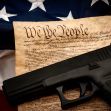Geoffrey S. posted notices on Facebook that he was buying “ammo” to protect himself from a government takeover and COVID vaccines with tracking devices. He owned several shotguns. His social media posts were filled with conspiracy theories and allegations such as claims that Bill Gates had already killed millions. Police had been called to his home several times, and a clinician from the Psychiatric Emergency Response Team (PERT) found him anxious, delusional and paranoid. He received a short psychiatric hold. The police petitioned for a one-year Gun Violence Restraining Order (GVRO) and the trial court issued it. At a July 2021 hearing, Geoffrey S. argued that all the evidence against him was moot and inadmissible hearsay. In a 2-1 decision, Justices from the California Court of Appeal disagreed.
Drawing parallels with workplace violence restraining orders (WVRO) and civil harassment restraining orders (CHRO), Justice Martin N. Buchanan of Division One of the Fourth Appellate District found that hearsay evidence is “likewise admissible at GVRO hearings.” He confirmed that the evidence the trial court received at the July hearing “was sufficient to establish by clear and convincing evidence” that the defendant/appellant “posed a significant danger of causing personal injury by gun violence.” The one-year GVRO issued by San Diego Superior Court Judge Judy S. Bay was affirmed. Judge Bay had allowed witness statements and summaries of his Facebook posts to be admitted as evidence despite hearsay objections from Geoffrey S.
Justice William Dato wrote a 12-page dissent that argued the legislature never intended hearsay to be admissible under the Penal Code.
Section 18175 (c)(1)states, “If the court finds that there is clear and convincing evidence to issue a gun violence restraining order, the court shall issue …an order that prohibits the subject…from having in (his) custody or control ...a firearm or ammunition.” A following section says that “if there is not clear and convincing evidence, the court shall dissolve” the GVRO.
Justice Buchanan began his opinion by concluding that there was clear and convincing evidence that Geoffrey S. posed a significant danger of causing personal injury by gun violence. He then summarized the appellant’s social media posts, encounters with the police, psychiatric evaluations, hospital stays, medications, confessions about his guns and ammunition, and interactions with other conspiracy theorists. He reviewed the police reports and law enforcement declarations that supported the GVRO because “There are no less restrictive means to ensure public safety.”
The opinion also included information about the defense exhibits that Geoffrey S. submitted at his trial. These included a psychiatric evaluation by a hearing officer who concluded that Geoffrey’s “strange beliefs were insufficient to support psychiatric illness.” He was released even though Dr. Samuel Etchie of the Alvarado Parkway Institute (Alvarado) where he was confined after his trial, diagnosed him with ”bipolar disorder, severe with psychotic features.” He also noted that the defendant refused to take prescribed medication.
Other exhibits included evidence showing Geoffrey was a licensed attorney in Chicago, declarations from his father claiming he was buying ammunition to protect his family, and a body-camera video in which he told the police he “did not intend to hurt anyone.”
After a summary of the facts, the District Court opinion first ruled that the GVRO was not moot even though it had expired. Justice Buchanan cited precedent that held an expired restraining order is not moot if it could have “collateral consequences in future proceedings” and because it is in the public interest to prevent gun violence.
Buchanan then went into a detailed description of the GVRO statute. He detailed the various types of protective orders and the time limits and details of requisite hearings. Here, he began his arguments supporting the inclusion of hearsay because Section 18155 of the Penal Code says that the court “may
consider any other evidence of an increased risk for violence.” (Italics included in original)
Next came the Court’s explanation of similarities between the GVRO and other restraining orders. WRVOs allow restraining orders of up to three years when there are unlawful threats of violence and appropriate hearings are held. Similarly, CHROs allow restraining orders of up to five years if there is “clear and convincing evidence of great or irreparable harm.” Both allowed all relevant testimony.
Buchanan concluded that the same rationale the courts applied in the other restraining order cases must be applied to Geoffrey S. This rationale is based on both the language of the Penal Code and the Evidence Code. The Penal Code permits consideration of “any evidence of an increased risk of violence.” “Any,” he wrote, “permits a court to consider “any testimony that is relevant.” In addition, the Penal Code specifically allows consideration of “documentary evidence including police reports….” The legislative history of the Penal Code shows that lawmakers “deliberately expanded the language of the bill to permit courts to consider …”any other evidence relevant to show an increased risk of violence.”
The Second Amendment which gives people the right to bear arms says nothing about hearsay evidence, the opinion added. The court also dismissed Geoffrey’s argument that his Sixth Amendment right, which gives him the right to confront witnesses against him, was violated. The court said the defendant’s hearsay objections at trial were “insufficient to preserve constitutional claims.
The opinion’s final analysis reviewed whether the “record as a whole contains substantial evidence from which a reasonable fact finder could have found it highly probable” by clear and convincing evidence that there was a high probability that Geoffrey S. “posed a significant danger of committing gun violence.” Geoffrey S.’s behavior met that test. In addition, the hearsay evidence in question “came from multiple sources that were consistent with one another.” This included his pastor, friend, Facebook posts and the defendant himself.
His claims that his First Amendment rights of free speech in which he expressed “strange beliefs” were violated were also dismissed; the court held these claims were forfeited because they were never previously raised and would have been rejected if they had been. Buchanan wrote that the First Amendment “does not prohibit the evidentiary use of speech to establish the elements of a crime or to prove motive or intent.”
In a time when gun violence heads the news all too often, it is encouraging that a man who had guns, ammunition and psychosis can be restrained by hearsay and corroborating evidence that he poses a significant danger.






